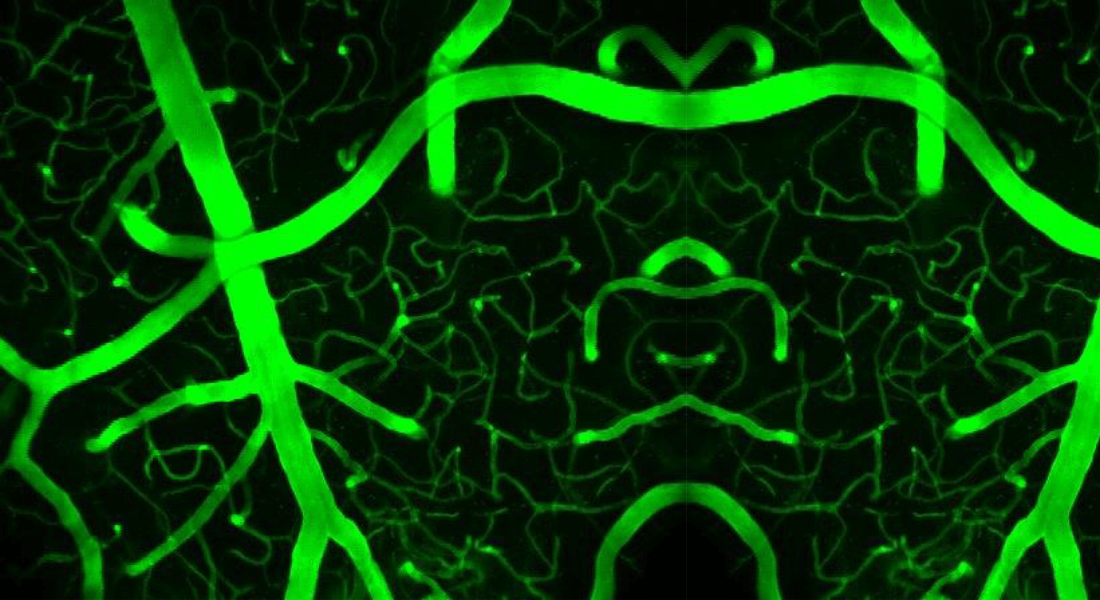Fluorescent mouse blood will help us gain knowledge about brain diseases
A fluorescent protein makes it possible to follow disease progression in brain diseases such as Alzheimer’s, strokes, and depression. That may lead to better insight into diseases and possible new treatments.

Did you ever think of jellyfish or a salamander as fluorescent?
That is actually the case. Both animals have proteins in their bodies that enables them to light up.
Researchers from the University of Copenhagen now invented a way to use these fluorescent proteins to gain new knowledge about brain diseases like depression, Alzheimer’s, and strokes.
“We developed a new method to visualize the blood flow in the brain in experimental mice for months,” says professor at the Center for Translational Neuromedicine at the University of Copenhagen, Hajime Hirase. He is one of the researchers behind the new method.
Before the newly developed method, the researchers used chemical dyes instead. That dye only made it possible to observe the blood flow in the brain for a few hours at a time.
Marie Curie fellow Antonis Asiminas who also worked on the method adds that the method brings brand new possibilities to track disease progression over time.
“There is already evidence, that blood flow is affected in several different diseases. So, it is a tool that can be used in many of those, especially long term progression of diseases.”
Less stress for mice
Because the new method induces the mice to produce harmless fluorescent proteins to label the blood, rather than chemical dyes, the mice only need to have an injection once unlike multiple times and every few hours. That reduces stress and pain for the mice.
“The mouse tail has very thick blood vessels where we normally inject dyes in. Then, if we look in a microscope, we can see nicely labeled blood, but this only lasts for one or two hours. Our new method labels the blood for months,” Hajime Hirase says.
By using fluorescent proteins instead, the researchers can better implement the “3R’s”, which are principles for ethical use of animals in research. The principles aim to refine animal testing, reduce the number of animals in research and in some cases to completely replace the animals for other methods.
“It addresses two of the three R’s. It’s both Refinement, because we are reducing stress for the animals, but it is also Reduction, because we can do longer studies in the same animal repeatedly so reducing the number of animals as well,” explains Antonis Asiminas.
The researchers use mice, because they have similar biology to humans and there are many valuable mouse models for human diseases, in which the researchers can use their new method.
Tricks the liver into making blood fluorescent
The blood contains a large amount of albumin, a protein produced in the liver. To make the blood fluorescent, the researchers took the gene of a fluorescent protein and attached that to the gene of albumin. This fluorescent albumin gene is then packed into a genetically modified virus. When mice are injected with this virus, their blood becomes fluorescent. This genetically modified virus does not lead to any disease and cannot spread to other animals or humans.
”Half of the blood is blood cells and the rest is fluid called plasma. My graduate students Xiaowen Wang and Christine Delle calculated that if we label a few percent of albumin, we should be able to see green fluorescent blood by microscopy,” says Hajime Hirase and Antonis Asiminas adds:
”We pack the modified genes that have the information for albumin and the fluorescent protein into a virus that we inject to the animal. The virus goes into the liver and tricks the liver to produce the modified protein which at the end makes the blood fluorescent.”
By using a process that occurs naturally in the body, they can trick the mice’s livers into making the blood fluorescent. That makes it possible to study the blood flow in the brain.
”It is a way for us to really study disease in a way that we could not do before. The goal and aim are that it will give us a new insight to disease progression and development in e.g. stroke that can hopefully lead to better understanding and possible treatment,” Antonis Asiminas explains.
The study “Liver-secreted fluorescent blood plasma markers enable chronic imaging of the microcirculation” is published in Cell Reports Methods.
Contact:
Professor Hajime Hirase
hirase@sund.ku.dk
+45 93 50 93 98
Dr Antonis Asiminas
a.asiminas@sund.ku.dk
Journalist and Press Officer Sascha Kael Rasmussen
sascha.kael.rasmussen@sund.ku.dk
+ 45 93 56 51 68
